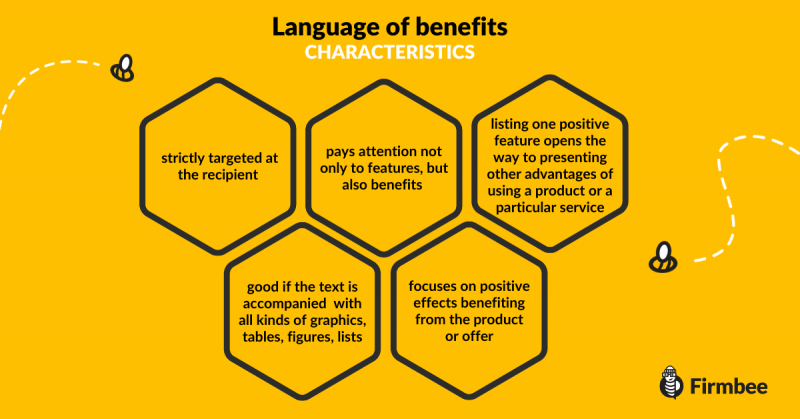Persuasion is the art of non-intrusive, subtle presentation of the advantages of a specific solution that is useful to the recipient. In marketing, this issue is very often referred to as benefit language. How to effectively use words to persuade the consumer to purchase the advertised product or service?
Learn how to use language of benefits in your advertising and learn the 3 rules of benefit-based content.
Language of benefits – topics covered:
- Language of benefits in advertising. Why is it so important?
- Rule number 1: Know your target audience
- Rule number 2: Raw information and benefit
- Rule number 3: Use trusty patterns to construct your appeal
- Language of benefits – examples
Language of benefits in advertising. Why is it so important?
Benefit language in sales is considered to be one of the most powerful tools for intensifying the desire to finalize the purchase of a product or service. The phrase itself refers directly to the way communication flows. As in any language, in the language of benefits the message must be organized flawlessly and coherently. The efficient words picking is aimed at creating a desire: this, in turn, pushes the potential customer to take advantage of an attractive offer.
Language of benefits consists of formulating a welcoming message and delivering it efficiently to the consumer. The message should be neither intrusive nor overwhelming. It should depict the product or service in a comprehensive, attractive and tempting way.
Only a small number of companies mastered the language of benefits. This can be compared to speaking another language. You can see at a glance if a person speaks it correctly or if he/she makes cardinal mistakes all the time. These in turn are detrimental and easily spotted by the recipient.

Rule number 1: Know your target audience
Messages constructed in accordance with the principles of the language of benefits must be strictly targeted at the recipient. This means that the specificity of the message must be tailored to interests, temperament or needs of the people to whom the message is addressed.
It will differ accordingly, for instance, advertising a medical product for seniors will have a different tone than offering fashionable clothes for young people. The message has to be profiled, clear and useful for the recipient.
When formulating the message for young people, it is worth betting on energy, joy or entertainment. The message for the elderly should be warm, safe and calm. In other words, it must be tailored to the general characteristics represented by the target group.
Rule number 2: Raw information and benefit
There is a significant difference between communicating bare features of a product and listing the benefits of using the item. Language of benefits must focus on presenting the positive effects of using the product in practice.
However, this does not mean that we should abandon presenting raw information. Both benefits and basic features have similar value. The trick is to gracefully and skillfully combine them in the best proportions.
Language of benefits is a blend of objective characteristics and the desired benefit.
Rule number 3: Use trusty patterns to construct your appeal
Even the technically flawless advertising text won’t succeed without additional, complementary graphic elements.
Raw content, even if it is interesting, will not attract the attention of the potential recipient. Therefore, the message, using the language of benefits, must be supplemented with all kinds of graphics, tables, figures, lists, various headings, hashtags, bolded or underlined.
The main reason for using these components is to amplify your appeal of the visual message. A colorful, structured message is more attractive to the recipient.
Language of benefits – examples
Below are some examples of content formulated in accordance with the principles of the language of benefits. It is worth noting that their structure is very often schematic: listing one positive feature opens the way to presenting other advantages of using a product or a particular service. This is one of the easiest ways to construct an interesting and attractive message for the consumer.
Let’s suppose the advertised product is a portable garden table.

- Lightweight construction – the plastic parts of the table are comfortable and lightweight, so moving it does not cause any problems.
- Compact construction – the table can be folded and unfolded in a few dozen seconds: an ideal solution for spontaneous parties with friends.
- Reliable stability – additional constructional safety features increase the table’s stability, so it is always safe to use.
- Express cleaning – don’t like scrubbing the table-top? No problem. Just rinse the table surface with water, wipe it with a dry cloth, and you’re done.
Do you have any experience with writing in the language of benefits? Or maybe you’d like to share your point of view? Let us know in the comments.
See also: Web writing principles – how to write for the internet?
Want to stay in touch with our content? Join our Facebook community
Author: Mira Bodhi
Knows all the pros and cons of working as a Freelancer and still makes the best of it. Time management and self-motivation are her biggest advantages. She is now a digital nomad and works traveling all over the world.


















